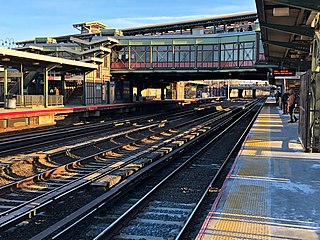
The Woodside station is a station on the Main Line and Port Washington Branch of the Long Island Rail Road (LIRR), located in the Woodside neighborhood of Queens in New York City. It is the first station passed by eastward trains from Penn Station and Grand Central Madison, and it is the only station in Queens shared by the Port Washington Branch and other LIRR branches. East of Woodside the two-track Port Washington Branch turns eastward, while the four-track Main Line continues southeast to Jamaica station.

The Port Washington Branch is an electrified, mostly double-tracked rail line and service owned and operated by the Long Island Rail Road in the U.S. state of New York. It branches north from the Main Line at the former Winfield Junction station, just east of the Woodside station in the New York City borough of Queens, and runs roughly parallel to Northern Boulevard past Mets-Willets Point, Flushing, Murray Hill, Broadway, Auburndale, Bayside, Douglaston, Little Neck, and then crosses into Nassau County for stops in Great Neck, Manhasset, and Plandome before terminating at Port Washington.

Flushing–Main Street is a station on the Long Island Rail Road's Port Washington Branch in the Flushing neighborhood of Queens, New York City. The station is located at Main Street and 41st Avenue, off Kissena Boulevard.
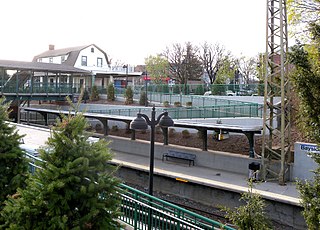
Bayside is a station on the Long Island Rail Road's Port Washington Branch in the Bayside neighborhood of Queens, New York City. The station is located at 213th Street and 41st Avenue, off Bell Boulevard and just north of Northern Boulevard, and is 12.6 miles (20.3 km) from Penn Station in Midtown Manhattan. The station is part of CityTicket.
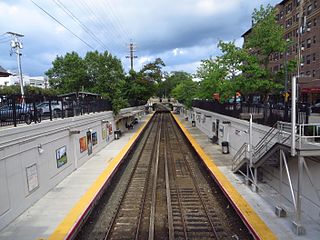
Great Neck is a station on the Long Island Rail Road's Port Washington Branch in Great Neck Plaza, New York. It is the westernmost station on the branch in Nassau County. The station is located at Middle Neck Road and Station Plaza at Great Neck Road, 0.25 miles (0.40 km) north of Northern Boulevard and 15.9 miles (25.6 km) from Penn Station in Midtown Manhattan. From just east of the station, the line becomes single track to Port Washington.

The Montauk Branch is a rail line owned and operated by the Long Island Rail Road in the U.S. state of New York. The line runs the length of Long Island, 115 miles (185 km) from Long Island City to Montauk. However, in LIRR maps and schedules for public use, the term Montauk Branch refers to the line east of Babylon; service from Jamaica to Babylon is covered by separate Babylon Branch schedules, while the line west of Jamaica is currently unused for passenger service. A select number of Montauk Branch trains operate via the Main Line during peak hours.

The Kew Gardens station is a station on the Main Line of the Long Island Rail Road (LIRR). It is located in the Kew Gardens neighborhood of Queens, New York City, near Austin Street and Lefferts Boulevard. The station is located within the City Terminal Zone, part of LIRR fare zone 1. It contains four tracks and two side platforms for the outermost tracks.
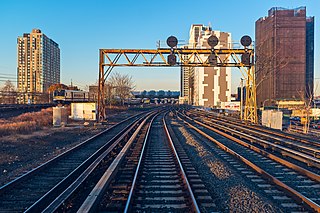
The Main Line is a rail line owned and operated by the Long Island Rail Road in the U.S. state of New York. It begins as a two-track line at Long Island City station in Long Island City, Queens, and runs along the middle of Long Island about 95 miles (153 km) to Greenport station in Greenport, Suffolk County. At Harold Interlocking approximately one mile east of Long Island City, the tracks from the East River Tunnels and 63rd Street Tunnel into Manhattan intersect with the Main Line, which most trains use rather than using the Long Island City station.
The South Side Railroad of Long Island was a railroad company in the U.S. state of New York. Chartered in 1860 and first opened in 1867 as a competitor to the Long Island Rail Road, it was reorganized in 1874 as the Southern Railroad of Long Island and leased in 1876 to the LIRR. After a reorganization as the Brooklyn and Montauk Railroad in 1879 it was merged in 1889.

The Whitestone Branch was a branch of the Long Island Rail Road, running north and east along the left bank of the Flushing River from the Port Washington Branch near the modern Willets Point/Flushing sections of Queens, New York. It crossed the river on one of the three bridges that were later torn down for the Van Wyck Expressway, then ran north along Flushing Bay and east along the East River to Whitestone.
The Long Island Rail Road is a railroad owned by the Metropolitan Transportation Authority in the U.S. state of New York. It is the oldest United States railroad still operating under its original name and charter. It consolidated several other companies in the late 19th century. The Pennsylvania Railroad owned the Long Island Rail Road for the majority of the 20th century and sold it to the State in 1966.

The Richmond Hill station is a closed station on the Montauk Branch of the Long Island Rail Road in the Richmond Hill neighborhood of Queens in New York City. The station is located at Myrtle Avenue and cuts diagonally from the intersection of Jamaica Avenue and Lefferts Boulevard through to Hillside Avenue. The station has two tracks and an island platform. Richmond Hill was the only station on the Lower Montauk Branch that was elevated with a high-level platform for passengers to wait for trains; the others were at ground level, with low-level platforms.
Central Railroad of Long Island was built on Long Island, New York, by Alexander Turney Stewart, who was also the founder of Garden City. The railroad was established in 1871, then merged with the Flushing and North Side Railroad in 1874 to form the Flushing, North Shore and Central Railroad. It was finally acquired by the Long Island Rail Road in 1876 and divided into separate branches. Despite its short existence, the CRRLI had a major impact on railroading and development on Long Island.

Winfield Junction is a junction between the Main Line and Port Washington Branch of the Long Island Rail Road in the Woodside section of Queens, New York City. Between 1854 and 1929, a station of the same name stood on this site.

Haberman was a station along the Long Island Rail Road's Lower Montauk Branch that was located at the intersection of Rust Street and 50th Street in Maspeth, Queens. The station is named after the Haberman Steel Enamel Works in Berlin Village.

Glendale was a Long Island Rail Road station along the Lower Montauk Branch, located in Glendale, Queens at Edsall Avenue and 73rd Street, near Central Avenue, at the All Faiths Monuments factory for the All Faiths Cemetery. This station had two "platforms" which were just strips of pavement besides the tracks signed as the station, and two tracks.
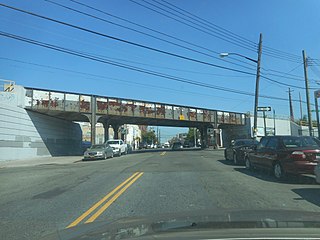
Corona was a station along the Port Washington Branch of the Long Island Rail Road in the Corona section of Queens, New York City. It was one of two stations built by the Flushing Railroad in Corona, this one having been at Grand Avenue and 45th Avenue. The station first opened as Fashion Race Course in March 1855. It was then renamed West Flushing, once the West Flushing station at 108th Street closed, and possibly when the race track was closed in 1869, and later renamed Corona around June 1872 when the Post Office was opened under the name of Corona. The race pens were located on this street which led directly north to the Fashion Race Course.

The Flushing and North Side Railroad was a former railroad on Long Island built by Conrad Poppenhusen as a replacement for the former New York and Flushing Railroad. The railroad was established in 1868, was merged with the Central Railroad of Long Island in 1874 to form the Flushing, North Shore and Central Railroad, and was finally acquired by the Long Island Rail Road in 1876. Today the main line is known as the Port Washington Branch of the Long Island Rail Road.
The White Line was a short-lived branch of the Long Island Rail Road in western Queens County, New York. Officially known as the Newtown and Flushing Railroad, the line was chartered in 1871, but was only in service from 1873 to 1876.
Maspeth station was a stop along the original New York & Flushing Railroad that opened on January 15, 1855. Maspeth station was located at Covert Avenue, now 58th Street, at Joy Street, now 54th Drive. So far as is known, there was no depot building. This station was discontinued very early on, probably in 1858. The segment between what was to become the former Laurel Hill station and Winfield station, was abandoned for passenger service in 1875, including the location of the Maspeth station, and completely abandoned in 1880. Part of the right-of-way ran through what is today the Mount Zion Jewish Cemetery in Maspeth. The Flushing and Woodside was merged into the Flushing and North Side in 1871, and its line was abandoned in favor of the ex-New York and Flushing line.
















